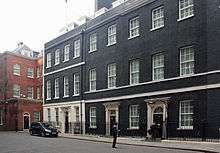12 Downing Street

12 Downing Street is one of the buildings situated on Downing Street in the City of Westminster in London, England. It has been traditionally used as the office of the Chief Whip although the upper floor forms part of the residential apartment for the Prime Minister of the United Kingdom. It has been owned and used by the Crown since 1803, first housing the Judge Advocate General of the Armed Forces and then the Colonial Office, before the office of the Chief Whip moved into the premises in 1879 until 2001. It is a Grade II listed building.
Current use
The offices of the Prime Minister in 10 Downing Street have spread into 12 Downing Street, connected by a corridor which runs through 11 Downing Street.[1] Under the current government, the building is being used to house the Prime Minister's Press Office and Strategic Communications Unit.[2][3] Although historically the house was used as the office of the Chief Whip, they are now located in 9 Downing Street.[4] The upper floor of 12 Downing Street forms part of the Prime Minister's personal apartment. This stretches from number 12 across to number 10 as a joint apartment.[5]
Historical use
The land which 12 Downing Street is built on was first sold by Charles Downing to James Steadman in 1723. The house was then sold in 1772 to William Maseres, who leased it three years later to Henry Hunt. This lease was bought out by Simon Frazer, who also acquired Maseres' stake in the property. After Frazer's death in 1783, it was sold by the executors to James Martin, who in turn sold it to the East India Company in 1803. It was purchased by the Crown in 1803, and was first used to house the Judge Advocate General of the Armed Forces. In 1827, it was taken over by the Colonial Office.[6]
When Downing Street was remodelled in 1846, the houses at 10, 11 and 12 were joined together as a single overall building,[7] with the Colonial Office continuing to reside there.[6] They moved out in 1879 and since then the house at 12 Downing Street has been historically used as the office of the Chief Whip of the Government,[8] and was also used for parliamentary dinners.[9] In 1854, Herbert Gladstone was born at 12 Downing Street, the son of then Chancellor of the Exchequer, William Ewart Gladstone. Herbert later became Home Secretary and the first Governor-General of the Union of South Africa.[10]
During the First World War, the premises was the headquarters of the Parliamentary Recruitment Committee.[11] It was formed across parties, and managed by the three Chief Whips during the Second Asquith ministry of 1915-16.[12] Following the breakup of the coalition government, the Liberal Party Chief Whip, John Gulland was blamed in some parts of the media for disconnecting the phone line running to 12 Downing Street. This was denied, and a statement was issued to say that "At no time was the telephone temporarily disconnected."[13] The building was made Grade II listed on 14 January 1970.[14]
The residency of the Chief Whips at 12 Downing Street ended in 2001, when Alastair Campbell was moved into the location from an office in 10 Downing Street by Prime Minister Tony Blair.[15] The Whips were moved to 9 Downing Street, previously only known as the Privy Council building.[15] During Gordon Brown's period as Prime Minister, he moved the Press Office back out of 12 Downing Street and instead used it as an open-plan office for himself and his key advisers. This was because there was an individual space large enough for Brown and his advisers, something which was not available in 10 Downing Street.[16]
Notes
- ↑ Seldon, Anthony. "History: 10 Downing Street". Gov.uk. Retrieved 3 April 2015.
- ↑ Singleton, David (8 October 2010). "New PR role created at Downing Street". PR Week. Retrieved 3 April 2015.
- ↑ Franklin (2005): p. 304
- ↑ d'Ancona, Matthew (16 July 2014). "Michael Gove is now Chief Whip to the nation". Evening Standard. Retrieved 3 April 2015.
- ↑ Booth, Lauren (23 May 2010). "Stand Your Ground, Sam. Living in No10 Will Send You (and David ) Mad". The Mail on Sunday. Retrieved 3 April 2015 – via HighBeam Research. (subscription required (help)).
- 1 2 "No. 12, Downing Street". British History Online. Retrieved 3 April 2015.
- ↑ "Prime Minister's Residence". Life: 47. 14 February 1949. Retrieved 3 April 2015.
- ↑ "Court and Personal". Huddersfield Chronicle (9086). 11 September 1896. p. 4. Retrieved 3 April 2015 – via British Newspaper Archive. (subscription required (help)).
- ↑ "The Meeting of Parliament". Manchester Courier and Lancashire General Advertiser. LXXI (11917). 19 January 1895. p. 6. Retrieved 3 April 2015 – via British Newspaper Archive. (subscription required (help)).
- ↑ "Lord Gladstone". Yorkshire Evening Post (12271). 28 January 1930. p. 9. Retrieved 3 April 2015 – via British Newspaper Archive. (subscription required (help)).
- ↑ "The Parliamentary Recruiting Committee". Aberdeen Journal (18695). 7 December 1914. p. 9. Retrieved 3 April 2015 – via British Newspaper Archive. (subscription required (help)).
- ↑ Oakes (2009): p. 87
- ↑ "Chief Whip's Telephone". Aberdeen Journal (19327). 13 December 1916. p. 3. Retrieved 3 April 2015 – via British Newspaper Archive. (subscription required (help)).
- ↑ "12, Downing Street Sw1, Westminster". British Listed Buildings. Retrieved 3 April 2015.
- 1 2 Womack, Sarah (7 September 2001). "Campbell ousts the Chief Whip". The Daily Telegraph. Retrieved 3 April 2015.
- ↑ "Brown quits 10 Downing Street to run the government from 'open plan war room' in No.12". Daily Mail. 13 October 2008. Retrieved 3 April 2015.
References
Coordinates: 51°30′12.2″N 0°07′41.1″W / 51.503389°N 0.128083°W
